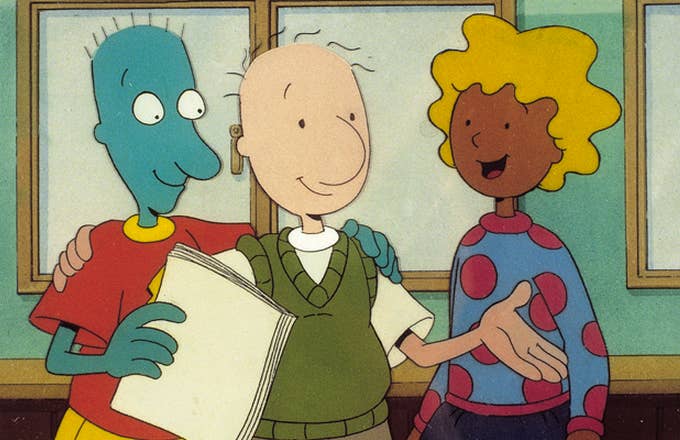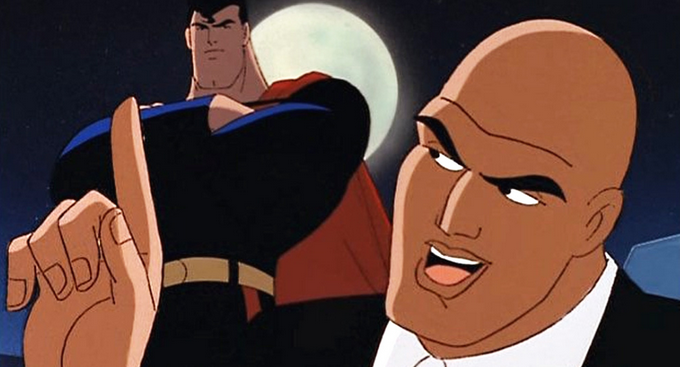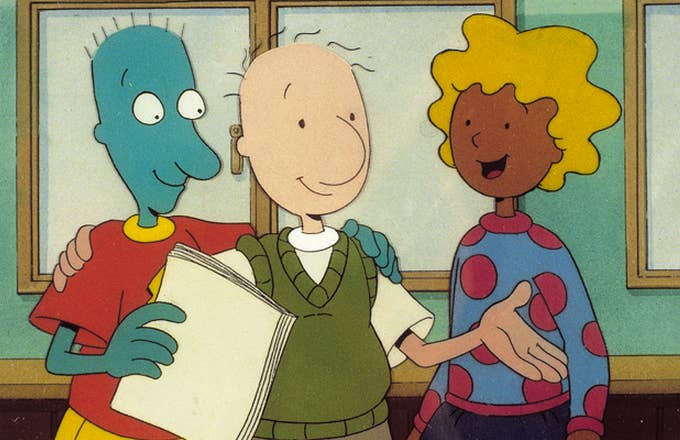
This past weekend I watched a Facebook thread of 40-plus comments devolve into conjecture and madness. The Facebook friend of mine had prompted: “Was Patti Mayonnaise from the cartoon Doug black? I say no. John says yes. What do you say?"
While Doug’s characters are famously varied in color—Skeeter Valentine is blue, Roger Klotz is green, etc.—there's apparently much disagreement among fans as to whether the show's characters are indeed different races. Until this week, I hadn’t even known that so many Doug fans assume that Skeeter is black. Meanwhile, one of our news anchors, Jinx, proposes that both Patti and Skeeter are white, but Beebe is black. Staff writer Angel Diaz, who is Puerto Rican, insists that Patti Mayonnaise is Puerto Rican.
Once and for all, let’s figure this out.
Conversation between Justin Charity (@brothernumpsa) and Frazier Tharpe (@The_SummerMan)
CHARITY: First, let's get this much out of the way: Skeeter Valentine is white. He is not to be confused with the eponymous character from Nickelodeon's My Cousin Skeeter, a show about a family that is obviously black. Shouts out to the diverse lot of Skeeters in this world.
As for Patti Mayonnaise, she's one of the few plainly shaded characters on Doug. She is brown. She is seven shades darker than Doug Funnie, though, admittedly, this measurement gets a bit tricky when you consider how inconsistently shaded she is from season to season of the series' original run on Nickelodeon. Disney's pixie-cut Patti Mayonnaise is the blackest version of all. I don't really see the ambiguity, but people really do disagree about this.
There's an abundance of distressing Patti Mayonnaise fanart and cosplay in Google Images. Frazier, be careful.
FRAZIER: *shudders* You weren't lying, Justin. It's been awhile since I've thought about Doug, so I Googled to refresh myself. And the images support your claim, more or less. Patti is indeed a few shades darker than everyone else. Compared to her, Doug is whiter than The Wire Season Two. Her hair, while blonde, is drawn in circa 2014-Blue Ivy tufts. She's also been known to sport the Halle Berry, or as we've come to call it in this post-Empire world, the Boo Boo Kitty™. But, further visual research produces a counter-argument, namely: her parents. This man is clearly Caucasian, fam. And her Mom? We should just go ahead and assume dude used Shelly Long for reference. Maybe Patti is just super tan, like Lex Luthor, whom adolescent Frazier always assumed was black up until I discovered the great Clancy Brown, well, isn't.
2.

CHARITY: In Slimed!, Doug producer Doug Campbell addressed the racial implication of Roger's being green, Beebe's being purple, Patti's being auburn, etc. The intention, he says, was to obscure the notion of race while ironically appealing to non-white audiences. Sounds like some Inception shit.
Doug is set in Bluffington, a fictional town that series creator Jim Jinkins based on his (and my) hometown of Richmond, Va. Jinkins, born in 1953, is white. He based many of Doug's characters on his childhood friends and classmates in the '60s South. When Jinkins talks about Skeeter's racial ambiguity, I take that as confirmation that he wasn't specifically interested in illustrating non-white characters in his cartoon. Which, duh, that's status quo.
Just look at The Simpsons. For all the supposed advantages of racial ambiguity, TV cartoonists are quick to illustrate characters as explicitly black, brown, or Asian when they're interested in casting stereotypes and cracking jokes about minorities. Which yields a predicament: apart from characters who function as subjects of racial humor, is it even possible to conclude, definitively, whether a character is black? Is Anthy Himemiya supposed to be Indian? Does India even exist in Revolutionary Girl Utena? Is Piccolo black? Answer me!
In Doug, Bluffington School flies a U.S. flag, so we know it's staged in America. And what is America without repressed-yet-obvious racial tension and passive-aggressive suggestions (per Campbell) that race is invisible.
FRAZIER: Interesting that you bring up characters solely there to provide racial humor. Suddenly the racial blurring becomes much sharper. Did Patti (who is voiced by Constance Schulman, a white woman) exhibit character traits with which we'd readily assign to a black person? Furthermore, why are we even asking this question to begin with? It's fun, for example, to hear Angel offer reasons why she must've been Puerto Rican, but why do we need to have a Racial Draft over her? Is it because, even when The Simpsons, with its yellow protagonists still has a black Carl and need-I-say-more Apu, it just seems like a less blatant zigzag in lacing even our cartoons with predominately white casts? Are we waiting for the animated world's answer to Empire? (Cuz it surely isn't/wasn't Cleveland Show.)

CHARITY: I'd assumed that Patti Mayonnaise was black because, blonde hair aside, she looks black! She's not a black stereotype, sure. But in a younger, innocent time, I hadn't realized that most illustrators will only cast a character as explicitly black if they "talk black" and "act black," which is unfortunate. Admittedly, I'm not one to demand that I be represented or reflected in more of the fictional characterizations I consume. (It's a tiresome demand, at this point.) But in general, we ask these questions because showrunners stay offering lame and perplexing rationalizations of whites-only casting even in cartoon shows! For all of Doug Campbell's insistence that Doug was a post-racial Blufftopia, it's naive to overlook the fact that the titular character and his family are, indeed, white.
FRAZIER: Welp, she definitely isn't black—her surname is Mayonnaise for Chrissakes. But we're always going to have these discussions when cartoons pretend to be racially ambiguous but are really just, surprise!—lily white of a different shade, supported by stereotypical minority archetypes. This is why I rock with Hey Arnold!, fam, no games played. At the end of the day though, if a blonde-haired, maybe-black girl and the green version of Screech help kids see personality before race, who are we to call out the inherent bullshit? Excuse me while I go brainstorm the animated answer to Empire.


